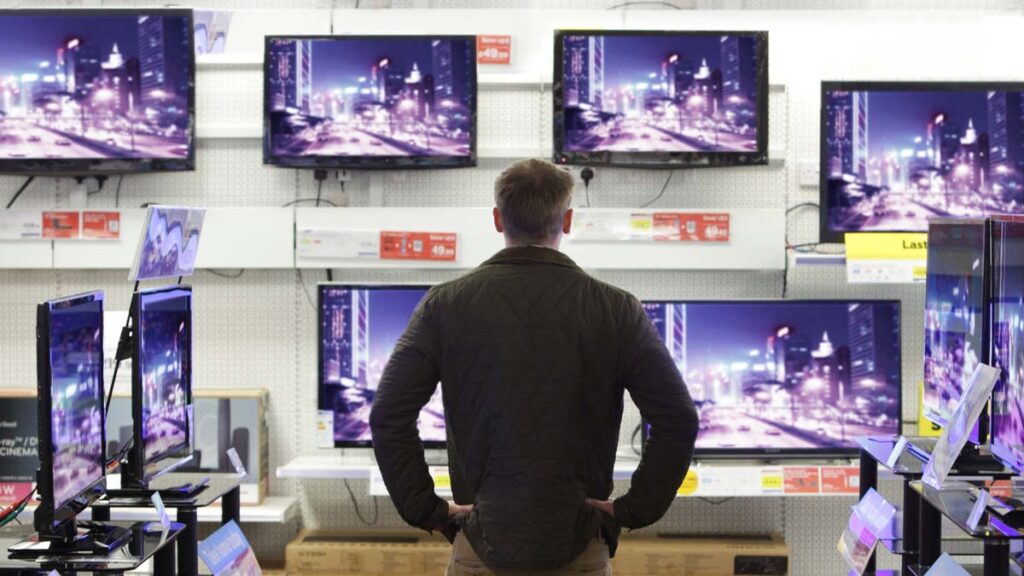Buying a new TV these days can be a stressful and confusing process because there are more choices than ever. So let me give you some advice on what to look for when buying a TV, what’s important, and if you really don’t want to shop around, a tip or two that will help you with your upcoming purchase TV.
I promise we’ll help you through the process and you’ll end up with a shiny new TV to play video games on! Or at least, you’ll have a better idea of what to look for when you or someone you know does some info shopping.
3 must-have features
By 2024, all modern TVs will have a host of features and options included in the box. UHD this, VRR that, etc. all Which is equally important for gamers. Here are the top three things to make sure your potential new TV has:
1. 4K/120hz screen is a must
Nowadays, you really should invest in a 4K/UHD TV. While 1080p/720p TVs will be much cheaper in 2024, the price gap is narrowing and the amount of content designed for 4K is growing rapidly.
Xbox Series X, PS5 and PS5 Pro all support 4K games and videos. Even if you don’t own one of these consoles yet, future devices will all support 4K (or higher), so you’ll want to future-proof your TV.
Oh, make sure it’s at least 120HZ so you can play something like fort night and call of Duty The frame rate is higher than the standard 60 FPS. This will make your game look silky smooth. It’s hard to get back to 60FPS fort night Once you get to 120, trust me.
2. Lots of HDMI 2.1 ports
Playing games at 4K/120 FPS is great, but to do it you’ll need more than a fancy new TV. You’ll also want to make sure your TV has an HDMI 2.1 slot. And preferably more than one.
HDMI 2.o only supports 4K/60FPS, while HDMI 2.1 allows you to play games at 4K resolution at 120 FPS (assuming you also have a 2.1 cable). (In case you were wondering, the HDMI cable included with your PS5 or Xbox Series console supports 2.1.) So make sure your next TV has a 2.1 port.
You might think that all new TVs have plenty of HDMI 2.1 ports, but you’d be wrong. Many cheaper devices only include two or three HDMI ports. Sometimes there is only one HDMI 2.1 slot. Or sometimes not! So be sure to take a close look at the box and check online that the TV you’re looking at has the right number and type of inputs you need.
If you have more than two modern gaming consoles and other devices plugged into your TV (such as a Blu-ray player or PC), the lack of an HDMI 2.1 port can quickly become a problem.
3. OLED may go bankrupt
Technically, you can still buy some nice LED/LCD TVs. (Now they are basically the same thing because IGN Explained in this very helpful guide.
LED/LCD screens cannot provide the same high brightness and deep blacks as OLED TVs. Additionally, if you buy an LCD/LED TV too cheaply, you may get one that uses edge lighting, which creates a halo effect on the outer ridges of the screen. These TVs are also difficult to see in bright rooms, and in darker scenes you’ll notice a distinct gray-black cast in the night sky or in a dark room. OLED, on the other hand, will give you pure black night skies and shadows, resulting in a better image since the pixels can be turned off completely.
2 must-have features
Depending on how much you’re willing to spend and what you want to get out of your new TV, here are two features that might be great.
1.VRR (variable refresh rate)
If the idea of uncapping game frame rates or running games at speeds above 30 but below 60 sounds unappealing or confusing to you, then you probably don’t need VRR. If you never notice frame rate stutters or screen tearing when playing games, then you probably don’t need VRR either.
But if you do care about the smoothness of your image, and you do enjoy tweaking visual settings on your console or PC game, then VRR is worth looking for in your next TV. The technology essentially allows the TV’s display rate to dynamically change to match your content, providing a smoother image. It’s not a miracle worker, a really poorly optimized game that keeps dropping frames and jumping from 20 FPS to 50 FPS that won’t be smoothed by VRR, but for a lot of console games that drop from 60 FPS to 5oish FPS, this Technology will make it harder to spot water droplets.
2. A good TV operating system
If you’re planning to just use your TV for gaming, you don’t really need to worry about the software it’s running, since you can just turn it on, boot up your console, and get on with your day.
But if you plan on watching movies or using smart TV apps like YouTube or Max on your new TV, then I recommend you do some research on the various operating systems used by different devices.
The best way to find out which operating system is best for you is to check out Reddit and YouTube. Watch videos of people using TV menus to learn which operating systems are slow and whether the TV you want is too low-powered to run TV software properly.
Of all the manufacturers, LG tends to have the best devices and the best operating systems. It’s snappy, clean, easy to use, and offers options I care about. The LG App Store isn’t as large as Roku or Google TV’s offerings, but it does include YouTube and most other “big” apps.
Some 4K TV recommendations
Well, maybe you don’t want to do any research and just want me to tell you which TV to buy. I can do that, but I still recommend checking some basic facts about a TV before buying one. You’ll probably spend $1,000 or more on this thing, so make sure it’s something you actually want!
Both of the TVs I recommend are LG sets because, in my experience (and conversations with other TV enthusiasts), the company does make the best, easiest to use, and most reliable 4K TVs on the market right now.
Anyway, here are my two suggestions.
The “cheap” option
If you want a solid 4K/120FPS gaming TV and don’t want to spend more than $1,000, your best bet might be LG B4 48-inch OLED Kit. It is equipped with 4 HDMI 2.1 ports and supports VRR technology through Gsync. LG’s software is good and fast. You can usually find this TV on Amazon and Best Buy for under $700, making it a great value.
The “expensive” option
If you want a bigger, better TV for gaming and you don’t mind spending over $1,500 on a TV, you should probably buy it LG C4 OLED Kit. So what’s the benefit of the extra $700+ compared to the B4 option above? Well, you get everything that the B4 includes, plus a bigger screen, since I recommend either 55 inches or 65 inches depending on your room. You also get brighter pictures with better contrast. It has a better processor inside, which helps navigate menus, but also allows the TV to better upgrade content.
Ultimately, both of these TVs are likely to be significant upgrades over any TV you’ve had sitting in your game room for more than five years. Especially if that TV is a cheaper LCD TV you bought during a Black Friday sale a few years ago.
Really, it depends on how much you care about small features and how much you’re willing to spend. Either way, the B4 or C4 are both great choices and worth buying this holiday season for yourself or the gamer in your life who keeps complaining about your old TV.

